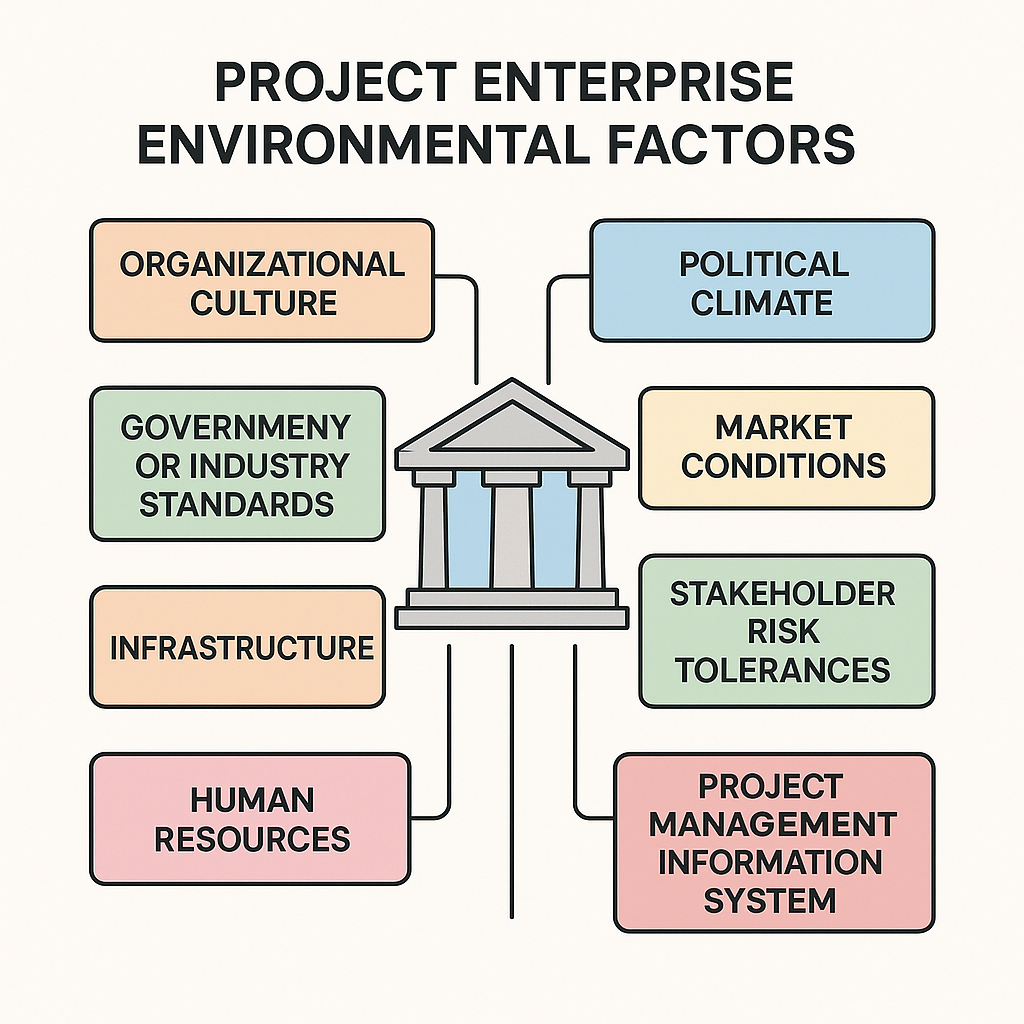
Enterprise environmental factors (EEF) comprises of all those factors from outside or inside the project organization, that can affect the project positively or negatively. For example:- Climatic conditions, political climate, global warming, manpower availability, raw material availability, labour laws, geographical conditions etc…
Factors that can affect the project outcomes in a positive or negative way. Can be internal or external. Examples – Climatic conditions, labour laws, workforce availability, government rules and regulations, raw material availability, political stability, geographical factors, transportation facilities etc….
Enterprise Environmental Factors (EEFs) refer to internal and external factors that influence or constrain a project’s execution, management, and outcomes. These factors are unique to each organization and its operating environment. Understanding and managing EEFs are critical for effective project planning, decision-making, and execution. Here’s a breakdown of enterprise environmental factors:
- Organizational Culture and Structure:
- The culture, values, norms, and behaviors prevalent within the organization.
- The organizational structure, hierarchy, reporting relationships, and decision-making processes.
- Organizational Process Assets:
- The organization’s internal resources, tools, templates, and standardized processes related to project management.
- Historical project data, lessons learned, best practices, and past project performance information.
- Infrastructure:
- Physical and technological infrastructure available within the organization to support project activities.
- Facilities, equipment, technology, and communication systems used for project execution.
- Human Resources:
- The skills, expertise, knowledge, and experience of the organization’s workforce.
- Staffing levels, availability of talent, team dynamics, and organizational roles and responsibilities.
- Government and Regulatory Requirements:
- Laws, regulations, standards, and guidelines imposed by government agencies or regulatory bodies.
- Compliance requirements related to health, safety, environment, quality, and other regulatory aspects.
- Market Conditions and Industry Standards:
- Market trends, economic conditions, competitive landscape, and industry benchmarks.
- Industry-specific standards, certifications, and best practices relevant to the project.
- Stakeholder Influences:
- The interests, expectations, and preferences of project stakeholders, including customers, sponsors, end-users, and regulators.
- Stakeholder relationships, power dynamics, and communication preferences.
- Organizational Policies and Procedures:
- Organizational policies, guidelines, rules, and procedures governing project management activities.
- Governance frameworks, project management methodologies, and quality assurance processes.
- External Dependencies and Constraints:
- Dependencies on external entities, such as suppliers, vendors, partners, or contractors.
- External factors beyond the organization’s control, such as market conditions, political changes, natural disasters, or technological disruptions.
- Financial Resources and Budgets:
- Financial constraints, budgetary limitations, funding availability, and financial planning processes.
- Resource allocation decisions, cost control measures, and financial forecasting practices.
- Risk Appetite and Tolerance:
- The organization’s willingness and capacity to take risks and tolerate uncertainty.
- Risk management policies, procedures, and strategies implemented to identify, assess, and mitigate project risks.
- Geopolitical and Socioeconomic Factors:
- Geopolitical events, social trends, cultural differences, and global economic conditions that may impact project execution and outcomes.
- Local, national, and international factors that influence project stakeholders, markets, and resources.
By considering these enterprise environmental factors, project managers can assess the internal and external context in which their projects operate and adapt their plans, strategies, and approaches accordingly. Effective management of EEFs can help mitigate risks, leverage opportunities, and improve project outcomes.
